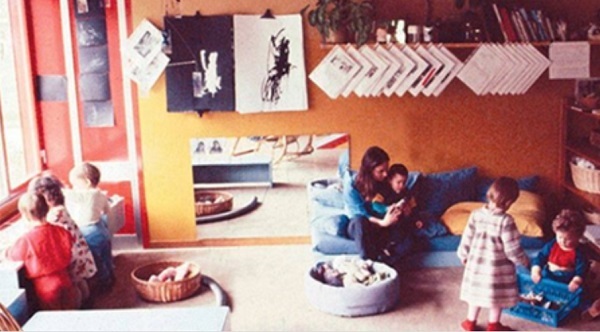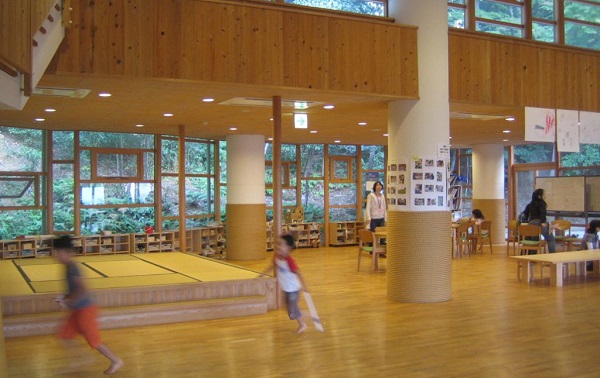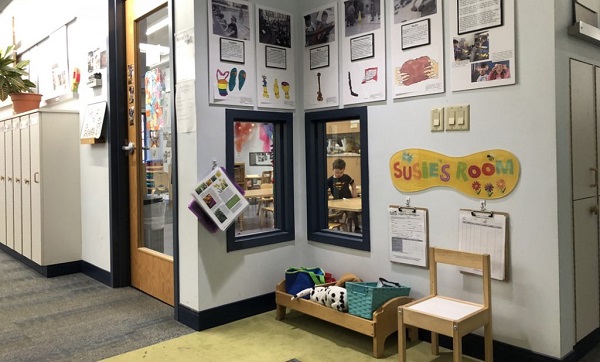
How a kid-friendly, playful home can teach your kids a thing or two
Photo: A school designed according to the Reggio Emilia Approach.
By Bea Spolidoro
Principal at Fisher ARCHitecture
Childhood memories are very powerful. Even if you don’t remember the faces or the names of people, you should have at least some memories of the location where events took place. Places have a big role in triggering emotional memories and can open “stargates” into our past.
Homes are small reproductions of the world around us. Schools can even be considered small cities with their own clearly defined rules and culture! In Montessori and Reggio Emilia Schools, classrooms are designed to support a teaching philosophy that – particularly in the Reggio Emilia Approach for early childhood – is self-directed and based on direct experiences.
In the Reggio Emilia Approach, space is imagined as a “Third Teacher”; third, that is, after parents and instructors. Kids learn about the complexities of the world by observing and touching different materials and experiencing a variety of spaces of different sizes and shapes. They learn to create social bonds with teachers and schoolmates in environments that resemble small towns. It is not uncommon to find an indoor “piazza” which is the core of all public activities outside of the classrooms. Kids also learn a lot by putting on display their creations and those of their young fellows. This documentation of the kids’ progress is useful to the teacher and parents as it allows them to tailor the curriculum to the kids and monitor their progress.
There is a lot to be said about space as a third teacher: Depending on when and where a person is born, their home can “teach them” about the time and place where they live. A traditional Japanese home, for example, is designed to facilitate taking off your shoes and walking on warm, natural surfaces. Traditional homes on the Alps, to the contrary, are counting on people coming in with dirty boots and may feature stone floors, which are easier to clean, and more resistant to wear. Homes in cold climates traditionally have small windows while homes in hot climates have big openings that facilitate the movement of cool air, and so on.
First things first
You first have to consider basic safety features to know if your house is truly kid-friendly: Do you have proper railings and are those railings designed to prevent small kids from falling down or from climbing them? Do you have any exposed sharp corners? Is precious, delicate or dangerous stuff stored in a kid-proof area?
As well, you should be interested in how interactive and interesting your space is. Kids’ creativity thrives when they can experience many different materials. Wood, stone, marble, and ceramic floorings, to name a few options, each trigger different sensations, and lead to different sorts of play. Due to their low height, children are typically close to the ground and notice details that adults forget or simply don’t see. Wood floors, for example, with their fibers and patterns, can suddenly become a perfect background for epic car races. Stone floors can be the perfect ground to found a city. A carpet can become a sea or a forest, depending on its pile height and color… The goal is to stimulate kids’ fantasies and make them comfortable with unexpected, diverse situations and the feelings these situations generate.

During rainy days or quarantine times, kids are often allowed to watch lots of TV. Yet, there is a lot that can be seen through the windows for free! A kid-friendly home should feature floor-to-ceiling openings or other safe window configurations that children can access anytime to see the outdoors. Windows are wonderful occasions for kids to learn about the changing of seasons or the movement of light and shadows during the day. This also helps their circadian rhythm which can be disrupted by too much screen time. A bay window can become a little niche that a kid can use for a private, meditative time far from adults or other distractions. Finally, some Reggio Emilia schools even feature windows that connect two interior spaces, sometimes in unusual shapes, to simulate the effect of a small house. This provides kids with a needed sense of freedom, particularly during stressful situations.
Indoor space for play
Speaking of stress management, kids should have plenty of space to roam around indoors in a safe way. Lack of indoor open space is a missed opportunity for children to get exercise. While you cannot replace the experience of being outside, kids should have as much space as possible to play. At a different scale, kids should also be offered a choice of smaller spaces where they can hide and create their own micro-cosmos. Bunk beds or beds and sofas that allow for hiding underneath make wonderful shelters that can protect kids from stress. Ultimately, allowing kids to choose from many different space sizes as they play increases their sense of ownership and control.

Contemporary homes are often impersonal. Most extensive multi-family complexes, in particular, are not “great teachers” at all. The charm of traditional construction methods, interesting use of materials, and unexpected massing strategies is often lost. Inside, the units can be even more boring, with maybe only one change of flooring material between the bathroom and the rest of the house. The imperative for project stake-holders as they build is to save money, of course. The real cost, though, is to the people and the kids that have to live in less stimulating environments.
Finding the perfect home is always a challenge. Parents find it difficult to move because, as they undertake their research, they quickly learn that new construction is very expensive and that existing homes often require extensive up-front work. Yet the places where they live are often not OK. Many parents face challenges bigger than having a “playful” home. Yet, a lot can be done even in small spaces. Architects can help people remodel their existing homes in creative ways or assist them in designing new ones so that they can be more experiential without breaking the bank.
A stimulating, interesting home is a good investment for kids from zero to a hundred.
Bea Spolidoro is a principal at Fisher ARCHitecture, based in Pittsburgh.